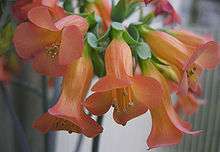Bryophyllum delagoense
| Bryophyllum delagoense | |
|---|---|
 | |
| Flowers | |
| Scientific classification | |
| Kingdom: | Plantae |
| (unranked): | Angiosperms |
| (unranked): | Eudicots |
| (unranked): | Core eudicots |
| Order: | Saxifragales |
| Family: | Crassulaceae |
| Genus: | Bryophyllum |
| Species: | B. delagoensis |
| Binomial name | |
| Bryophyllum delagoensis | |
| Synonyms[1] | |
| |
.jpg)
Bryophyllum delagoensis is a succulent plant native to Madagascar. In common with some other members of its genus, B. delagoensis is notable for vegetatively growing small plantlets on the distal ends of its phylloclades, leading to its common names of mother of millions,[2] and devil's backbone.[2] Chandelier plant is an alternative common name.
This species' capability for vegetative reproduction, its drought tolerance, and its popularity as a garden plant, relate to this species' becoming an invasive weed in places such as eastern Australia and many Pacific islands. In the Neotropics hummingbirds sometimes pollinate this non-native plant.[3]
Bryophyllum delagoensis is unwelcome because it displaces native plants and contains bufadienolide cardiac glycosides[4] which can cause fatal poisoning, particularly in grazing animals like cattle.[5] During 1997, 125 head of cattle died after eating this species on a travelling stock reserve near Moree, NSW.[6]
Because of the toxicity of this species and its hybrids, and especially of the flowers, it has been declared a noxious weed in New South Wales and Queensland.
See also
Footnotes
- ↑ "The Plant List: A Working List of All Plant Species".
- 1 2 "Kalanchoe daigremontiana". Germplasm Resources Information Network (GRIN). Agricultural Research Service (ARS), United States Department of Agriculture (USDA). Retrieved 9 February 2015.
- ↑ For example sapphire-spangled emerald (Amazilia lactea) in Brazil (Baza Mendonça & dos Anjos 2005)
- ↑ Bryotoxins A, B and C: McKenzie et al. (1987), Steyn & van Heerden (1998)
- ↑ McKenzie & Dunster (1986), McKenzie et al. (1987)
- ↑ les tanner. "North West Weeds". Northwestweeds.nsw.gov.au. Archived from the original on 2009-06-21. Retrieved 2013-02-19.
References
| Wikimedia Commons has media related to: |
- Baza Mendonça, Luciana & dos Anjos, Luiz (2005): Beija-flores (Aves, Trochilidae) e seus recursos florais em uma área urbana do Sul do Brasil [Hummingbirds (Aves, Trochilidae) and their flowers in an urban area of southern Brazil]. [Portuguese with English abstract] Revista Brasileira de Zoologia 22(1): 51–59. doi:10.1590/S0101-81752005000100007 PDF fulltext
- McKenzie, R.A. & Dunster, P.J. (1986): Hearts and flowers: Bryophyllum poisoning of cattle. Australian Veterinary Journal 63(7): 222-227. doi:10.1111/j.1751-0813.1986.tb03000.x PMID 3778371 (HTML abstract)
- McKenzie, R.A.; Franke, F.P. & Dunster, P.J. (1987): The toxicity to cattle and bufadienolide content of six Bryophyllum species. Australian Veterinary Journal 64(10): 298-301. doi:10.1111/j.1751-0813.1987.tb07330.x PMID 3439945 (HTML abstract)
- Steyn, Pieter S & van Heerden, Fanie R. (1998): Bufadienolides of plant and animal origin. Nat. Prod. Rep. 15(4): 397-413. doi:10.1039/a815397y PDF fulltext